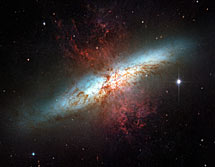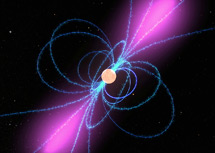

Tuesday - November 3, 2009
SLAC Today is
available online at:
http://today.slac.stanford.edu
In this issue:
Fermi Telescope Detects Gamma-Rays from "Star Factories" in Other Galaxies
Fermi Telescope Finds More New Pulsars
Public Lecture November 17: Zap! The X-ray Laser Is Born
 |
 |
|
Tuesday - November 3, 2009 |
Fermi Telescope Detects Gamma-Rays from "Star Factories" in Other Galaxies
M82, also known as the Cigar Galaxy, lies 12 million light-years away in the constellation Ursa Major. Fermi's Large Area Telescope and the ground-based VERITAS observatory have detected diffuse gamma rays from the galaxy's core, which produces stars at a rate ten times faster than our entire galaxy. (Image: NASA/ESA/Hubble Heritage Team (STScI/AURA)) Nearby galaxies undergoing a furious pace of star formation also emit lots of gamma rays, say astronomers using NASA's Fermi Gamma-ray Space Telescope. Two so-called "starburst" galaxies, plus a satellite of our own Milky Way galaxy, represent a new category of gamma-ray-emitting objects detected both by Fermi and ground-based observatories. "Starburst galaxies have not been accessible in gamma rays before," said Fermi team member Seth Digel, a physicist at SLAC. "Most of the galaxies Fermi sees are exotic and distant blazars, which produce jets powered by matter falling into enormous black holes. But these new galaxies are much closer to us and much more like our own." Gamma rays are the most energetic form of light. Fermi has detected more than a thousand point sources and hundreds of gamma-ray bursts, but the satellite also detects a broad glow that roughly follows the plane of our galaxy. This diffuse gamma-ray emission results when fast-moving particles called cosmic rays strike galactic gas or even starlight. Cosmic rays are hyperfast electrons, positrons, and atomic nuclei moving at nearly the speed of light. But, although Earth is constantly bombarded by these particles, their origin remains a mystery nearly a century after their discovery. Astronomers suspect that the rapidly expanding shells of exploded stars somehow accelerate cosmic ray particles to their fantastic energy. "For the first time, we're seeing diffuse emission from star-forming regions in galaxies other than our own," noted Jürgen Knödlseder, a Fermi telescope collaborator at the Center for the Study of Space Radiation in Toulouse, France. He spoke to reporters yesterday at the 2009 Fermi Symposium, which continues through November 5. Read more from NASA... Fermi Telescope Finds More New Pulsars (Image: Symmetry magazine.)
Yesterday at the 2009 Fermi Symposium in Washington, D.C., postdoctoral researcher Lucas Guillemot of the Max Planck Institute reported that the Fermi Gamma-ray Space Telescope has detected eight more pulsars that had not been seen in other wavelengths of light, bringing the total of these gamma-ray-only objects to 24. The telescope also bagged one new gamma ray millisecond pulsar. However, Guillemot said these results are preliminary and have not been submitted for publication yet. Pulsars are the remnants of supernovas – stars that run out of fuel, expand and then collapse into masses heavier than the sun but with an average radius of only 10 km. Pulsars emit powerful jets of radiation, and as they rotate the radiation sweeps across the cosmos like the beam from a light house. From Earth, it looks as though the neutron star's light is pulsing on and off. The vast majority of pulsars emit radio waves; that's how most of them were detected. But in blind searches of the sky, Fermi has found previously unknown pulsars that appear to radiate only gamma rays. It may be that these pulsars emit in radio wavelengths, too, but their radio beams are simply not visible from Earth; follow-up observations should reveal if they radiate in other frequencies, including radio. Fermi's discovery of a new gamma ray millisecond pulsar, or MSP, brings the telescope's tally up to nine. The pulse of light from an MSP has a period of milliseconds, meaning the neutron star is rotating hundreds of times per second and appears to blink rapidly. The gamma ray MSPs studied by Fermi had already been identified by radio telescopes; Fermi was the first gamma ray telescope to identify MSPs that radiate gamma rays. Read more in Symmetry Breaking... Public Lecture November 17:
|
Events
Access (see all)
Announcements
|
|
| | ||
|
|
||
 <%
Response.AddHeader "Last-modified", getArticleDate()
'Response.AddHeader "Last-modified","Mon, 01 Sep 1997 01:03:33 GMT"
'Monday, December 06, 2010
%>
<%
Response.AddHeader "Last-modified", getArticleDate()
'Response.AddHeader "Last-modified","Mon, 01 Sep 1997 01:03:33 GMT"
'Monday, December 06, 2010
%>View online at http://today.slac.stanford.edu/. |
||